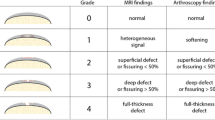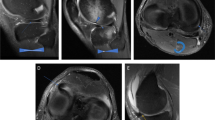Abstract
Purpose
The aim of this prospective study was to compare routine MRI scans of the knee at 1.5 and 3 T obtained in the same individuals in terms of their performance in the diagnosis of cartilage lesions.
Methods
One hundred patients underwent MRI of the knee at 1.5 and 3 T and subsequent knee arthroscopy. All MR examinations consisted of multiplanar 2D turbo spin-echo sequences. Three radiologists independently graded all articular surfaces of the knee joint seen at MRI. With arthroscopy as the reference standard, the sensitivity, specificity, and accuracy of 1.5- and 3-T MRI for detecting cartilage lesions and the proportion of correctly graded cartilage lesions within the knee joint were determined and compared using resampling statistics.
Results
For all readers and surfaces combined, the respective sensitivity, specificity, and accuracy for detecting all grades of cartilage lesions in the knee joint using MRI were 60, 96, and 87 % at 1.5 T and 69, 96, and 90 % at 3 T. There was a statistically significant improvement in sensitivity (p < 0.05), but not specificity or accuracy (n.s.) for the detection of cartilage lesions at 3 T. There was also a statistically significant (p < 0.05) improvement in the proportion of correctly graded cartilage lesions at 3 T as compared to 1.5 T.
Conclusion
A 3-T MR protocol significantly improves diagnostic performance for the purpose of detecting cartilage lesions within the knee joint, when compared with a similar protocol performed at 1.5 T.
Level of evidence
III.



Similar content being viewed by others
References
Adachi N, Ochi M, Deie M, Nakamae A, Kamei G, Uchio Y et al (2013) Implantation of tissue-engineered cartilage-like tissue for the treatment for full-thickness cartilage defects of the knee. Knee Surg Sports Traumatol Arthrosc. doi:10.1007/s00167-013-2521-0
Brittberg M, Winalski CS (2003) Evaluation of cartilage injuries and repair. J Bone Joint Surg Am 85-A(Suppl 2):58–69
Cameron ML, Briggs KK, Steadman JR (2003) Reproducibility and reliability of the Outerbridge classification for grading chondral lesions of the knee arthroscopically. Am J Sports Med 31:83–86
Crema MD, Roemer FW, Marra MD, Burstein D, Gold GE, Eckstein F et al (2011) Articular cartilage in the knee: current MR imaging techniques and applications in clinical practice and research. Radiographics 31:37–61
Figueroa D, Calvo R, Vaisman A, Carrasco MA, Moraga C, Delgado I (2007) Knee chondral lesions: incidence and correlation between arthroscopic and magnetic resonance findings. Arthroscopy 23:312–315
Friemert B, Oberländer Y, Schwarz W, Häberle HJ, Bähren W, Gerngross H et al (2004) Diagnosis of chondral lesions of the knee joint: can MRI replace arthroscopy? A prospective study. Knee Surg Sports Traumatol Arthrosc 12:58–64
Gold GE, Hargreaves BA, Stevens KJ, Beaulieu CF (2006) Advanced magnetic resonance imaging of articular cartilage. Orthop Clin N Am 37:331–347
Guermazi A, Hayashi D, Eckstein F, Hunter DJ, Duryea J, Roemer FW (2013) Imaging of osteoarthritis. Rheum Dis Clin North Am 39:67–105
Kijowski R, Blankenbaker DG, Davis KW, Shinki K, Kaplan LD, De Smet AA (2009) Comparison of 1.5- and 3.0- T MR imaging for evaluating the articular cartilage of the knee joint. Radiology 250:839–848
Kijowski R, Blankenbaker DG, Munoz Del Rio A, Baer GS, Graf BK (2013) Evaluation of the articular cartilage of the knee joint: value of adding a T2 mapping sequence to a routine MR imaging protocol. Radiology 267:503–513
Kijowski R, Blankenbaker DG, Woods M, Del Rio AM, De Smet AA, Reeder SB (2011) Clinical usefulness of adding 3D cartilage imaging sequences to a routine knee MR protocol. AJR Am J Roentgenol 196:159–167
Kijowski R, Gold GE (2011) Routine three-dimensional magnetic resonance imaging of joints. J Magn Reson Imaging 33:758–771
Link TM, Sell CA, Masi JN, Phan C, Newitt D, Lu Y et al (2006) 3.0 vs 1.5T MRI in the detection of focal cartilage pathology—ROC analysis in an experimental model. Osteoarthritis Cartilage 14:63–70
Masi JN, Sell CA, Phan C, Han E, Newitt D, Steinbach L et al (2005) Cartilage MR imaging at 3.0 versus that at 1.5T: preliminary results in a porcine model. Radiology 236:140–150
Menashe L, Hirko K, Losina E, Kloppenburg M, Zhang W, Li L et al (2012) The diagnostic performance of MRI in osteoarthritis: a systematic review and meta-analysis. Osteoarthritis Cartilage 20:13–21
Noyes FR, Stabler CL (1989) A system for grading articular cartilage lesions at arthroscopy. Am J Sports Med 17:505–513
Ramnath RR (2006) 3T MR imaging of the musculoskeletal system (part I): considerations, coils, and challenges. Magn Reson Imaging Clin N Am 14:27–40
Ramnath RR (2006) 3T MR imaging of the musculoskeletal system (part II): clinical applications. Magn Reson Imaging Clin N Am 14:41–62
Recht MP, Goodwin DW, Winalski CS, White LM (2005) MRI of articular cartilage: revisiting current status and future directions. AJR Am J Roentgenol 185:899–914
Riel KA, Reinisch M, Kersting-Sommerhoff B, Hof N, Merl T (1999) 0.2-Tesla magnetic resonance imaging of internal lesions of the knee joint: a prospective arthroscopically controlled clinical study. Knee Surg Sports Traumatol Arthrosc 7:37–41
Roemer FW, Crema MD, Trattnig S, Guermazi A (2011) Advances in imaging of osteoarthritis and cartilage. Radiology 260:332–354
Rubenstein JD, Li JG, Majumdar S, Henkelman RM (1997) Image resolution and signal-to-noise ratio requirements for MR imaging of degenerative cartilage. AJR Am J Roentgenol 169:1089–1096
Sanders TG, Miller MD (2005) A systematic approach to magnetic resonance imaging interpretation of sports medicine injuries of the knee. Am J Sports Med 33:131–148
Smith TO, Drew BT, Toms AP, Donell ST, Hing CB (2012) Accuracy of magnetic resonance imaging, magnetic resonance arthrography and computed tomography for the detection of chondral lesions of the knee. Knee Surg Sports Traumatol Arthrosc 20:2367–2379
Sonin AH, Pensy RA, Mulligan ME, Hatem S (2002) Grading articular cartilage of the knee using fast spin-echo proton density-weighted MR imaging without fat suppression. AJR Am J Roentgenol 179:1159–1166
Theologis AA, Haughom B, Liang F, Zhang Y, Majumdar S, Link TM et al (2013) Comparison of T1 rho relaxation times between ACL-reconstructed knees and contralateral uninjured knees. Knee Surg Sports Traumatol Arthrosc. doi:10.1007/s00167-013-2397-z
Vallotton JA, Meuli RA, Leyvraz PF, Landry M (1995) Comparison between magnetic resonance imaging and arthroscopy in the diagnosis of patellar cartilage lesions: a prospective study. Knee Surg Sports Traumatol Arthrosc 3:157–162
Van Dyck P, Vanhoenacker FM, Lambrecht V, Wouters K, Gielen JL, Dossche L, Parizel PM (2013) Prospective comparison of 1.5 and 3.0-T MRI for evaluating the knee menisci and ACL. J Bone Joint Surg Am 95:916–924
von Engelhardt LV, Kraft CN, Pennekamp PH, Schild HH, Schmitz A, von Falkenhausen M (2007) The evaluation of articular cartilage lesions of the knee with a 3-Tesla magnet. Arthroscopy 23:496–502
Wong S, Steinbach L, Zhao J, Stehling C, Ma CB, Link TM (2009) Comparative study of imaging at 3.0T versus 1.5T of the knee. Skeletal Radiol 38:761–769
Conflict of interest
The authors declare that they have no conflict of interest.
Author information
Authors and Affiliations
Corresponding author
Rights and permissions
About this article
Cite this article
Van Dyck, P., Kenis, C., Vanhoenacker, F.M. et al. Comparison of 1.5- and 3-T MR imaging for evaluating the articular cartilage of the knee. Knee Surg Sports Traumatol Arthrosc 22, 1376–1384 (2014). https://doi.org/10.1007/s00167-013-2704-8
Received:
Accepted:
Published:
Issue Date:
DOI: https://doi.org/10.1007/s00167-013-2704-8




